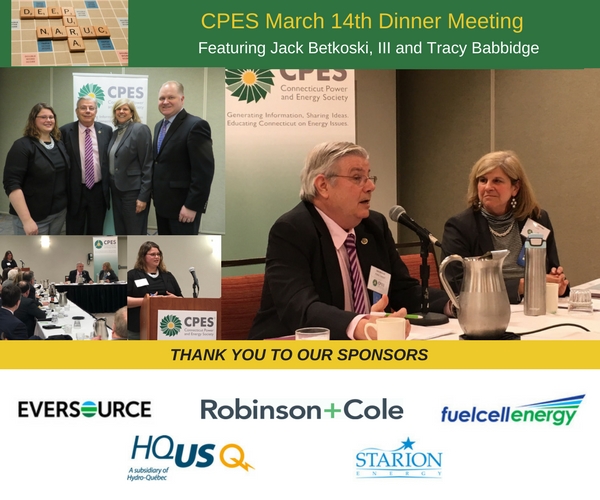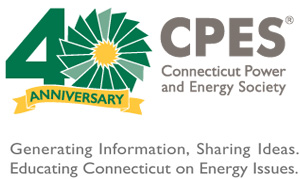This update features policy, regulatory, legislative, and regional developments in Connecticut and New England. The policy updates are compiled by the CPES New Energy Professionals Team. If you are interested in learning more about the New Energy Professionals, the Policy Committee, or if you have ideas for future policy updates, we would welcome your input and feedback. Please send comments to Kathryn Dube, CPES Executive Director, via email: kdube@ctpower.org.
In this Update:
- Senate Energy and Natural Resources Committee Holds Nomination Hearing to Consider FERC Nominees
- EIA: Electricity Prices Reflect Rising Delivery Costs, Declining Power Production Costs
- 2017 CES Technical Meeting on September 13: Agenda
REGIONAL AND INDUSTRY DEVELOPMENTS
U.S. SENATE ENERGY AND NATURAL RESOURCES COMMITTEE HOLDS NOMINATION HEARING TO CONSIDER FERC NOMINEES
On September 7, 2017, the U.S. Senate Energy and Natural Resources Committee held a nomination hearing to consider the nominations of Richard Glick and Kevin McIntyre to fill the two remaining seats on the Federal Energy Regulatory Commission (FERC).
The nominations of Neil Chatterjee and Robert Powelson were confirmed by the U.S. Senate in August, restoring a quorum to FERC for the first time since early February. For more information, visit the FERC website.
EIA: ELECTRICITY PRICES REFLECT RISING DELIVERY COSTS, DECLINING POWER PRODUCTION COSTS
Over the past decade, retail electricity prices have not closely followed the costs of fuels used to generate electricity, such as coal or natural gas, mainly because of changes in the other costs involved with producing and delivering electricity in the United States.
The average retail price of electricity in the United States has risen about 1.5% per year between 2006 and 2016, about the same as the 1.6% per year general rate of inflation over those years. In contrast, natural gas prices for U.S. electric generators, a key component in the cost of generating electricity, have fallen at an average rate of 8.4% per year since 2006.
The cost of electricity reflects money spent on generation, transmission, distribution, and other plant-in-service additions, as well as plant operation and maintenance. Over the past decade, the portion of total electricity costs attributed to power production for most utilities has decreased from 69% to 54%, while the portion associated with delivering that electricity to customers has risen. These costs are based on financial reports filed with the Federal Energy Regulatory Commission by major utilities and represent about 70% of all electric utility spending.
Power production costs incurred by utilities include fuel costs; nonfuel costs, including the costs of building, upgrading, operating, and maintaining generators; and the costs of purchasing power from independently-owned generators or from power markets. While the fuel and purchased power costs have decreased over the decade with the decrease in natural gas prices, nonfuel costs have increased slightly.
Electricity delivery costs have increased in real 2016 dollar terms from 2.2 cents per kilowatthour (kWh) in 2006 to 3.2 cents/kWh in 2016, roughly offsetting the decrease in the generation cost. Delivery costs include:
- Transmission expenses such as towers, poles, wires, substations, and communications equipment necessary to ensure reliable transmission of electricity from generators to neighborhoods
- Expenses for distribution equipment to deliver electricity at lower voltages to households and businesses
- Distribution expenses to install, operate, and maintain meters and sensors
- Customer billing, education, relations, and other services that allow customers to participate in utility programs such as energy efficiency, rebate, and time-of-use pricing programs
Transmission and distribution costs have risen for several reasons. In many areas, aging electric infrastructure has been replaced with new equipment that allows utilities to repair faults on transmission lines remotely, to read meters remotely, and to more quickly find, repair, and communicate with customers about neighborhood reliability problems and outages. Other infrastructure has been built to improve reliability and resiliency, to connect to new sources of electricity generation (including wind and solar), and to reduce transmission-line congestion in quickly growing areas.
Other costs associated with electricity, such as administrative and general expenses, have also risen by 20% in real dollar terms since 2006, but these costs account for a smaller portion of the overall costs of providing electricity
https://www.eia.gov/todayinenergy/detail.php?id=32812
http://www.theenergycollective.com/todayinenergy/2412322/electricity-prices-reflect-rising-delivery-costs-declining-power-production-costs
CONNECTICUT
DATES SET FOR THE DRAFT 2017 COMPREHENSIVE ENERGY STRATEGY TECHNICAL HEARINGS
The Connecticut Department of Energy and Environmental Protection (DEEP) released a draft of the 2017 Comprehensive Energy Strategy (CES) on June 26th. They will hold a technical meeting on September 13, 2017 at 11:00 a.m. in Hearing Room 1, at DEEP’s New Britain Office, Ten Franklin Square, New Britain, Connecticut Directions to DEEP’s New Britain Office. The purpose of the technical meetings are to allow stakeholders an opportunity to present oral comments and to pose questions to DEEP staff and consultants involved in the preparation of the analytics and the findings in the draft Strategy. DEEP requests that you RSVP and send your questions to DEEP.EnergyBureau@ct.gov three business days prior to the scheduled date if you plan on attending and/or participating in any of the scheduled technical meetings. Visit the DEEP website for more information.

